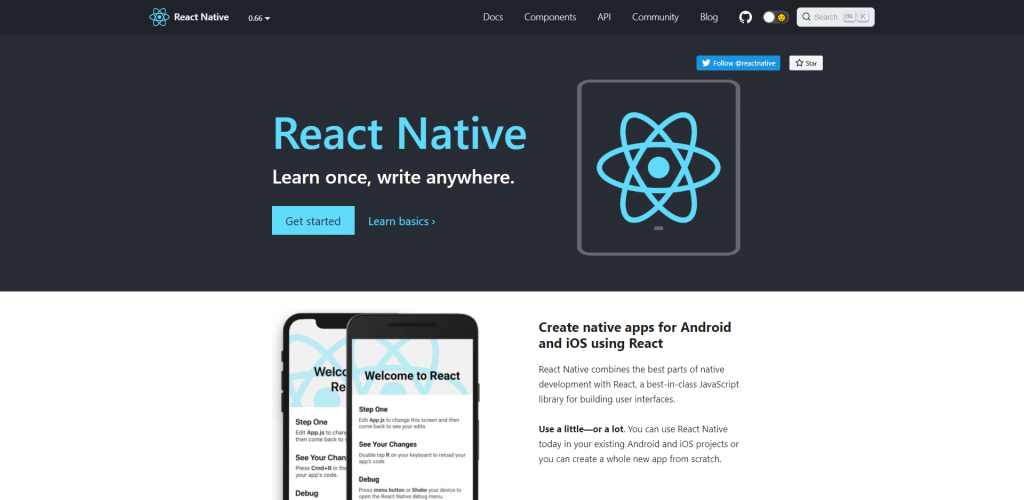Flutter vs React Native: which one to choose?

For two years now, React Native and Flutter have been the most popular tools for cross-platform software development of mobile apps, and their adoption rate continues to grow and outpace the competition.
Unlike a native development approach, Flutter and React Native allow the creation of a single code base that works for both iOS and Android devices. Since this requires less coding, apps can be deployed faster and on a smaller budget. This is one of the main reasons why these two mobile development toolkits have become popular.
In this article, we will dive into the world of these solutions and attempt the comparison between Flutter and React Native, in order to determine which one is better for app development in 2022 and we will contrast the pros and cons of React Native with those of Flutter using different criteria. Of course, before we do that, we’ll start by presenting each of the 2 options.
Introduction to Flutter
Created by Google, Flutter is free and open-source: Google’s solution is presented to us as a complete software development kit (SDK) for creating applications, with widgets and various additional tools.
As you know, Flutter enables cross-platform app development, and offers developers a simple way to create and deploy visually appealing, natively compiled apps for mobile (iOS, Android), web and desktop, all from a single code.
It is based on Dart, a fast, object-oriented programming language. Released in 2011, Dart is relatively new but still easy to learn, especially for experienced developers who already know Java and C#.
Flutter provides its own widgets, taken from its own high-performance rendering engine: these widgets are fast, attractive and of course, customizable. Again thanks to these widgets, Flutter applications look good and feel good, but you can create your own custom application design, using readily available UI elements that follow platform-specific guidelines.
The benefits of Flutter
Speed
Once you’re able to get past the tedious step that comes with installing Flutter, everything else goes really fast: unlike React Native, which uses JavaScript, the Flutter framework uses its own programming language, which makes the whole app development process easier because you don’t need any other third-party gateways.
Support for multiple devices
Flutter ensures that users get the same interface and functionality, even if they are using a smartphone with dated processors, or an older version of iOS or Android.
This helps maintain consistency and uniformity in the user experience, while ensuring that everyone can use these products.
Programming language
Flutter has a programming language, Dart, created specifically for it.
Dart is both fast and elegant, with a syntax similar to C++, making it a new favorite among developers.
Published
The Flutter platform is designed in such a way that applications created using it are quickly and easily published in online app stores such as the Play Store.
Documentation
The platform is also designed so that documentation of new application programs is quick and easy.
The disadvantages of Flutter
Installation
Flutter installation is usually very slow and complex.
To learn more, here are the installation tutorials for Windows, MacOS and Linux.
Programming language
Yes the programming language is also in the disadvantages.
The language used by Flutter, Dart, is relatively new. Most developers do not know how it works yet. It is currently quite hard to find developers who can use Flutter in a professional way.
Popularity
In the mobile app development market, Flutter is just starting to gain traction: other platforms like React Native are more popular and widespread, with a larger support community.
Lack of libraries
Flutter is a recent platform, and although it is open source (and has pre-built libraries), the number of features offered remains limited.
So it is up to the developer to create libraries from scratch and make them available to the community to help others, and fill this gap.
Large file size
Flutter’s file size can quickly become enormous. Due to its huge size, the application can sometimes become difficult to manage.
This is considered a disadvantage, but it groups several together because this feature could force the developer to turn to another platform that produces more compact files, and because an application that is too heavy takes up space on devices and will tend to run slow, especially on older models.
Introduction to React Native

React Native is an idea from Facebook, and has become very popular among developers very quickly, probably because it has been around longer than Flutter.
React Native uses the JavaScript programming language. It is popular among social networking companies. Tesla and Skype are among its most notable users.
React Native is a framework that allows cross-platform development, i.e. creating apps for Android and iOS using a single code base, using the popular JavaScript language. Applications created using React Native are not mobile web applications.
React Native uses the same fundamental UI elements as traditional iOS and Android apps: this means that instead of creating in Java, Kotlin or Swift, you assemble the same elements using JavaScript and React.
React Native finally has components that are similar to Flutter widgets.
The advantages of React Native
Popularity
React Native has been around for a while and gathers a large number of users, as well as about 42% of app developers.
Since it is an open-source framework, bugs and other issues can be easily resolved by asking peer developers. In addition, developers will be encouraged to share their code and products, and to grow the community even more each day.
Ease of use
Well known to developers, JavaScript is also quite simple to use. It is easy to find developers who have a thorough knowledge of JavaScript and therefore know how to use it perfectly.
Code reuse
This is a handy feature because most of the functions and codes are similar for both iOS and Android platforms. This reduces the time needed for the development process, thus improving the efficiency of the whole system.
Installation
The installation of the React Native framework is quite easy. You just need to have a good knowledge of Java.

Support for third-party libraries and plugins
Many third-party libraries with complex functions can be easily imported and used in your application.
This reduces development time, and the libraries are tested so there is very little risk of creating broken code or buggy applications by using them.
The disadvantages of React Native
Speed
React Native is not as fast as its Flutter counterpart. You will have to go through JavaScript bridges when developing an application.
Version and documentation
React Native follows standard manual procedures for release and documentation. This also makes the process quite slow.
Learning difficulty
Learning app development can be quite difficult with React Native, especially for beginners trying out the world of app development.
Also, to start using React Native, you need to have experience in native app development. Therefore, React Native is not the best option to start your app development career.
Poor memory management
Due to its Javascript-based framework, React Native is not very good at memory management. Complex calculations are also handled very inefficiently in React Native.
Therefore, it is not the best choice of framework for developing applications that have to perform complex tasks.
Weak security
The open-source nature of Java also has its drawbacks. Because every resource is open to the public, applications developed using React Native are very insecure and can be easily penetrated by another developer.
Thus, when it comes to creating applications related to the banking sector, for example, developers avoid using React Native.
Conclusion
There are advantages and disadvantages in both frameworks, and it is up to the developer to choose which platform will be best suited based on the task at hand and the type of application desired.
However, as they are open source platforms, the possibilities are immense in both cases, and they will only increase in the days to come as they continue to grow.
Find a Flutter or React Native developer available on Coder.com quickly by posting your free project!



